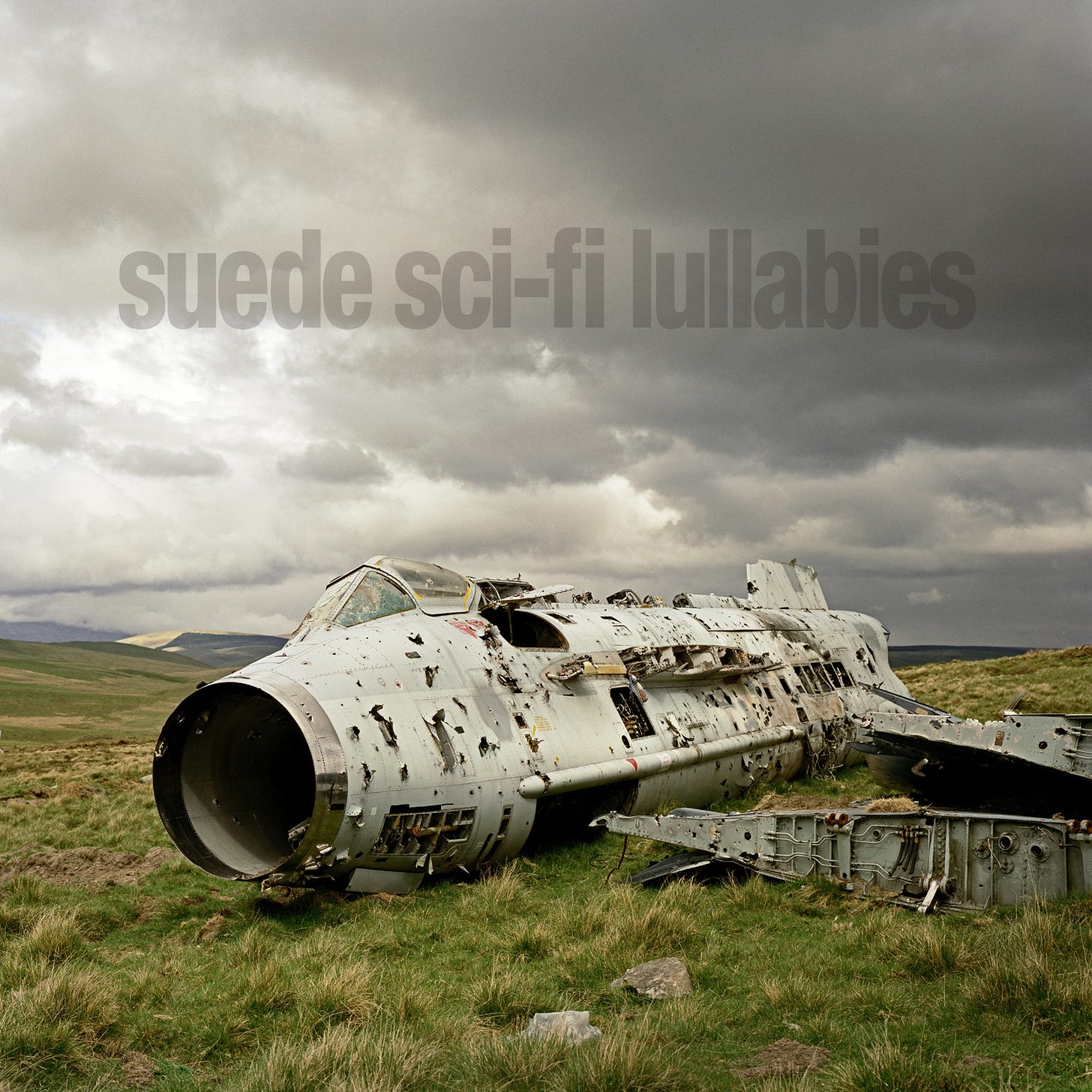Introducing the B-Sides: 10 Best from Sci-Fi Lullabies
Suede: a retro-flection, SECOND INTERMISSION
Released in 1997, Sci-Fi Lullabies is far more than a collection of B-sides. Suede’s B-sides are not just fillers. They are fully realized songs that often rivalled or even surpassed their A-side counterparts. These tracks gave the band space to experiment with mood, narrative, and sound, revealing an alternate side of their artistry that didn’t always fit on their albums but was no less essential to their identity.
In much the same way as the Smiths, renowned for elevating the B-side to an art form, Suede has always approached B-sides with the same seriousness as singles and album tracks. In a full-circle moment, Morrissey became an early champion of Suede, covering “My Insatiable One,” a B-side from their debut single, “The Drowners.” That endorsement was more than just flattery; it was a signal that Suede’s commitment to quality across all their releases had been noticed by one of their most significant influences.
For many fans like me, Sci-Fi Lullabies is an essential part of the Suede discography, and I can still recall the exact moment I learned about its existence. One Saturday in late 1997, I was home in Waterloo, Ontario, flipping through a recently purchased UK music magazine when I came across a full-page advertisement for the album. Until that moment, I had no idea Suede were releasing a compilation of B-sides. This was all before the Internet and social media, so it wasn’t unusual for me to learn about a new release by seeing an ad or reading about it in an imported magazine that was already weeks old. I immediately started calling around to the local record stores, hoping someone had it in stock. No luck. So I made a decision. I got in my car and drove to the HMV at 333 Yonge Street in Toronto. It was an hour-and-a-half trip each way, and I went with a single purpose: to buy the double CD. I'm not even sure if I called ahead to check if they had it in stock, but it was there when I arrived. After spending less than 10 minutes in the store, I turned around and drove straight home, listening to Sci-Fi Lullabies on my Discman, which was connected to my car stereo using a cassette adapter. That's how we did it in 1997.
While many bands treat B-sides as throwaways, Suede used them as a space to experiment, to explore new textures, and to craft some of their most emotionally resonant work. Out of the 27 songs on Sci-Fi Lullabies (which takes its title from a lyric in “Introducing the Band” from Dog Man Star), the ten tracks I’ve chosen here are among my favourite moments in the Suede canon, often outshining the singles which they supported.
“My Insatiable One”
(1992, B-Side to “The Drowners” UK 12-inch and CD single)
“My Insatiable One” holds a special place in Suede lore—and in my heart. As lyrically provocative as the A-side, it’s a quintessential early Suede track. While “My Insatiable One” wouldn’t have worked as the A-side, it’s a perfect companion piece for “The Drowners,” romantic, slightly silly and seedy, yet utterly captivating. It is the first great Suede B-side (no shade to its sister B-side, “To The Birds,” which was billed as the single’s AA on the 7-inch version), a truth that only became more prominent the following year by its absence from the self-titled debut and the inclusion of sub-par filler like “Animal Lover.”
“The Big Time”
(1993, B-Side to “Animal Nitrate” UK 7-inch, 12-inch, CD and cassette single)
“The Big Time” is a smoky, sultry ballad soaked in a noirish atmosphere that’s both seductive and slightly menacing. The lyrics allude to the trappings of fame that were closing in on the band, just as expectations and hype were reaching a fever pitch. Brett Anderson tends to agree with fans that “The Big Time” was a big level up for Suede: “I was really excited by it,” he’s quoted in David Barnett’s Suede: Love and Poison: The Authorised Biography, adding, “Bands like us didn’t get brass players in, or if they did they were playing some corny riff. Bands in our category weren’t making music that sophisticated.”
“The Living Dead”
(1994, B-Side to “Stay Together” UK 7-inch, 12-inch, CD and cassette single)
Another fan favourite, “The Living Dead,” didn’t sit well with Bernard Butler, who felt Brett Anderson’s lyrics about junkies and heroin addiction soiled his beautiful finger-plucked acoustic ballad. And while Anderson has gone on record saying that the song’s inspiration is a romantic couple he knew at the time who were drug users, he says, “They were really fun people. The song’s very tragic but they weren’t tragic in that sense.” It’s this contrast between the sweet, lullaby-like melody and the bleak subject matter that creates this haunting beauty.
“My Dark Star”
(1994, B-Side to “Stay Together” UK 7-inch, 12-inch, CD and cassette single)
Also from the “Stay Together” single, “My Dark Star” is a moody, mid-tempo track that could have slotted neatly onto Dog Man Star. Its problematic lyrics may not have aged gracefully, but the song’s atmosphere and arrangement are undeniably amongst the band’s best. “My Dark Star” is the kind of B-side that deepens the Suede mythology, as it’s always felt shadowy, romantic, and just a little bit dangerous.
“Killing of a Flash Boy”
(1994, B-Side to “We Are the Pigs” UK 7-inch, 12-inch, CD and cassette single)
Released with “We Are the Pigs” as part of the ground-shaking change-up that signalled the forthcoming Dog Man Star album, “Killing of a Flash Boy” is all swagger and snarl. It’s not my absolute favourite, but it’s undeniably catchy and has a staying power that sneaks up on you. I love hearing Anderson bark “And that shitter with the pout won’t be putting it about no more,” with such venom that it’s impossible to ignore. It’s a punk-glam anthem that could have been a standout on a different version of Suede’s second record, one that retained the punk vibes of the debut.
“Modern Boys”
(1994, B-Side to “The Wild Ones” UK 12-inch, CD singles 1 and 2, and cassette single)
“Modern Boys” is one of the most melodic and accessible tracks in Suede’s catalogue, and the only song that flirts with Britpop, but never fully commits. Destined for B-side status given how out of sync it was with most of Dog Man Star, it retains that signature Suede strangeness; an effortless curio that could easily be a standalone track. It’s a knockout for me, and a song I’ve always felt should have had its moment in the spotlight.
“Together”
(1995, B-Side to “New Generation” UK 12-inch, CD single 1, and cassette single)
The “New Generation” single was significant for a couple of reasons; it would be the final Suede release to feature music by Bernard Butler and also the first to feature music by new member Richard Oakes, in the form of the brilliantly catchy “Together.” It’s a song I had almost forgotten until revisiting Sci-Fi Lullabies, and now I can’t stop playing it. The story goes that with a day off on tour in Hamburg, Germany, the band and crew decided to have a night out in the town’s red light district, but exiled Oakes to his hotel room and told him not to leave until he’d written a song. When the band returned, Oakes turned in his assignment, marking a transitional moment in the band’s evolution, as it bridged the glam-pop of Suede 1.0 with the spikiness that would mark Suede 2.0 with Coming Up.
“Europe Is Our Playground”
(1996, B-Side to “Trash” UK 7-inch, CD single 1, and cassette single)
As excited as I was about the renewed vigour and energy I felt upon first hearing “Trash” in 1996, it was “Europe Is Our Playground” that fascinated me most about the band Suede were becoming at the time. Its music, written by bassist Mat Osman, felt revelatory and paradigm-shifting. It was loungey, louche, and paired with Anderson’s road-weary lyrics, “Europe Is Our Playground” became a decadent delight. I am explicitly referring to the original version of the song from the “Trash” single, not the re-recording that mars Sci-Fi Lullabies with its sluggishness and lifeless lumbering. The fact that they went with the new version remains my biggest complaint about Sci-Fi Lullabies, to the point where I’ve created a custom playlist that inserts the original (there, fixed it).
“Every Monday Morning Comes”
(1996, B-Side to “Trash” UK CD single 1)
“Every Monday Morning Comes” feels like a spiritual cousin to “Saturday Night” lyrically. Though it may not have fit the narrative arc of Coming Up, in another timeline on a different album, it could have been a grand opening or closing track, or even a top 10 single. Wistful and reflective, with a melody that lingers long after it ends, “Every Monday Morning Comes” is another one of those lost gems that Sci-Fi Lullabies shines a spotlight on as it opens CD2 of the compilation.
“W.S.D.”
(1996, B-Side to “Saturday Night” UK CD single 1)
Short for 'We’re So Disco,' “W.S.D” is an anomaly in the Suede canon up to its first appearance on the final single from Coming Up, but its funky and murky hypnotic qualities hint at where the band would be heading on its next album (1999’s Head Music). An Anderson solo composition, “W.S’D.” features some of the best stream-of-consciousness lyrics he’s ever penned; classic Suede subject matter that blurs the boundaries of gender, sexuality, addiction, lust, and romance and crystallizes it all in a singular, stand-out one chorus hook: “Oh, is it true what they say about you? / Oh, is it true what they say about you two?”
![the act of just being [t]here](https://substackcdn.com/image/fetch/$s_!moQy!,w_80,h_80,c_fill,f_auto,q_auto:good,fl_progressive:steep,g_auto/https%3A%2F%2Fsubstack-post-media.s3.amazonaws.com%2Fpublic%2Fimages%2Fedc03f78-2893-4045-9600-2bacb96b8fa5_1080x1080.png)
![the act of just being [t]here](https://substackcdn.com/image/fetch/$s_!pLeR!,e_trim:10:white/e_trim:10:transparent/h_72,c_limit,f_auto,q_auto:good,fl_progressive:steep/https%3A%2F%2Fsubstack-post-media.s3.amazonaws.com%2Fpublic%2Fimages%2F0d02a71c-d57a-4a4b-b90c-22191b1e1244_2688x512.png)


